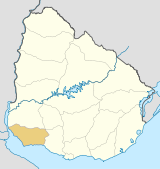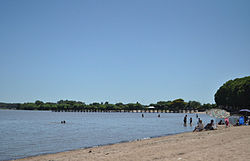- Nueva Palmira
-
Nueva Palmira — City — Coordinates: 33°53′0″S 58°25′0″W / 33.883333°S 58.416667°W Country  Uruguay
UruguayDepartment Colonia Department Founded 1831 Founder Felipe Santiago Torres Leiva Population (2004) - Total 9,230 Time zone UTC -3 Postal code 70101 Area code(s) +598 4544 Nueva Palmira (Spanish pronunciation: [nweβa palmi'ra]) is a city in Colonia Department in south-western Uruguay. It is located on the east bank of Uruguay River, about 86 kilometres (53 mi) northwest of the departmental capital Colonia del Sacramento.
Contents
History
It was founded on 26 October 1831 by Felipe Santiago Torres Leiva.[1]
Population
In 2004, it had a population of 9,230.[2]
Year Population 1963 6,306 1975 7,146 1985 7,151 1996 8,339 2004 9,230 Source: Instituto Nacional de Estadística de Uruguay[3]
Features
Nueva Palmira is considered an important commercial port of the area and offers docking facility for yachts. There are several beaches along its shore, like Playa Higuerita, Playa Eolo, Playa Corbacho and Playa Los Vascos, while the northern end of the city, along the shore, is a resort called Balneario Brisas del Uruguay.
Main streets and squares
The main streets are General J.G. Artigas and fellipe Fontana, both running SE to NW, converge at the southeastern end of town and join with Ruta 21 towards Carmelo. The other main street, Chile, runs SW to NE and extends to Ruta 21 towards Dolores and Mercedes of Soriano Department.
The main squares of the city are Plaza de los 33 Patriotas, which takes up two blocks and extends to the Muelle Viejo (Old Dock) at the waterfront, and Plaza Artigas, featuring a monument to José Gervasio Artigas and the main church of the city. There is also Plaza de Deportes which offers open doors sports facilities. The city has also a zoological garden in its northern part.
Government
The city mayor as of July 2010 is Andrés Passarino.[4]
Notable people
- Gianni Guigou, football player.
See also
References
- ^ nuevapalmira.net History of Nueva Palmira (www.nuevapalmira.net) (Spanish)
- ^ "2004 Census of Colonia department" (XLS). INE. 2004. http://www.ine.gub.uy/fase1new/Colonia/Cuadro7_05.XLS. Retrieved 4 July 2011.
- ^ "1963–1996 Statistics / N" (DOC). Instituto Nacional de Estadística de Uruguay. 2004. http://www.ine.gub.uy/biblioteca/toponimico/TOPOletraN.doc. Retrieved 4 July 2011.
- ^ "MUNICIPIOS DE URUGUAY" at the Intendents' Congress website (Spanish)
External links
- Nueva Palmira's website (Spanish)
- Information on the city at welcomeuruguay.com (Spanish)
- INE map of Nueva Palmira
 Coast of Colonia
Coast of Colonia 
Resorts
and
LandformsBrisas del Plata • Santa Regina (Playa Robert) • Los Pinos - Playa Fomento (Britopolis, Blanca Arena) • (Pta del Rosario, Boca del Rosario, Playa Charrua) • Juan Lacaze • Artilleros (Pta Artilleros, Playa Artilleros) - Santa Ana (Playa Santa Ana) - El Ensueño (Puerto Platero) • Riachuelo (Playa & Pta del Islote, Playa El Calabrés) • Colonia del Sacramento (Puerto de Colonia, Barrio Historico, Muelle del Yates, Playa de Colonia, Playa Real de San Carlos) • (Parque Anchorea, Barra de San Juan, Pta Francesca, Pta Pereira) • Puerto Inglés (Pta & Puerto Conchillas) • (Pta Martin Chico, Pta Dorado) • Carmelo (Pta Piedras, Playa Seré, Playa Coralito) • Zagarzazú (Playa Zagarzazú, Puerto Camacho) • Nueva Palmira (Pta Gorda, Puerto de N.Palmira, Playa de los Argentinos, Playa Higuerita, Playa Eolo, Playa Corbacho, Playa Los Vascos, Balneario Brisas del Uruguay)
Glossary : Balneario = Resort , Barra = Mouth (of river) , Barrio = Neighbourhood , Playa = Beach , Puerto = Port , Punta (or Pta) = Point, Small Peninsula  Colonia Department of Uruguay
Colonia Department of UruguayCapital: Colonia del Sacramento Towns and
villagesArrivillaga • Barker • Carmelo • Colonia del Sacramento • Colonia Valdense • Conchillas • El Semillero • Florencio Sánchez • Fomento • Horqueta • Juan Lacaze • La Paz • Los Pinos • Miguelete • Nueva Helvecia • Nueva Palmira • Ombúes de Lavalle • Rosario • Tarariras • Zagarzazú

Sights Categories:- Uruguay geography stubs
- Populated places in the Colonia Department
- Populated places established in 1831
- Argentina–Uruguay border crossings
Wikimedia Foundation. 2010.


